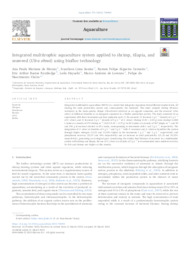Integrated multitrophic aquaculture system applied to shrimp, tilapia, and seaweed (Ulva ohnoi) using biofloc technology.
Integrated multitrophic aquaculture system applied to shrimp, tilapia, and seaweed (Ulva ohnoi) using biofloc technology.
Autoria: MORAIS, A. P. M. de; SANTOS, I. L.; CARNEIRO, R. F. S.; ROUTLEDGE, E. A. B.; HAYASHI, L.; LORENZO, M. A. de; VIEIRA, F. do N.
Resumo: Integrated multitrophic aquaculture (IMTA) is a model that integrates organisms from different trophic levels, all sharing the same production system and, consequently, the nutrients. This study adopted shrimp (Penaeus vannamei) as the main species, tilapia (Oreochromis niloticus) as an organic consumer, and the seaweed (Ulva ohnoi) at different densities as an inorganic consumer in a biofloc production system. The study consisted of an experiment with three treatments and four replicates each: 1) No seaweed; 2) Seaweed 1 g L-1 (density of 1 g L-1 of U. ohnoi), and 3) Seaweed 2 g L-1 (density of 2 g L-1 of U. ohnoi). Shrimp (3.82 ± 0.05 g) were stocked in 800 L tanks at a density of 275 shrimp m-3 , fish (14.44 ± 0.57 g) in 90 L tanks at a density of 267 tilapia m-3 , and 50 and 100 g of seaweed stocked in 50 L tanks, corresponding to treatments with 1 and 2 g L-1 , respectively. The integration of U. ohnoi at densities of 1 g L-1 and 2 g L-1 with P. vannamei and O. niloticus benefited the system through higher nitrogen (13,22 and 13,10% higher in the treatments 1 g L-1 and 2 g L-1 respectively) and phosphorus recovery (25,57 and 34% respectively) and an increase in total productivity (15,32 and 19,22% respectively), generating an ecological gain. Considering the similar final biomass of seaweed in a multitrophic system with shrimp and tilapia, the use of U. ohnoi at a density of 2 g L-1 is recommended since nutrient recovery by fish and shrimp was higher at this density.
Ano de publicação: 2023
Tipo de publicação: Artigo de periódico
Palavras-chave: Aquaculture systems, Biofloc technology, Biomass, Nitrogen, Phosphorus, Seaweed culture, Shrimp, Tilapia (common name)
Observações
1 - Por padrão são exibidas publicações dos últimos 20 anos. Para encontrar publicações mais antigas, configure o filtro ano de publicação, colocando o ano a partir do qual você deseja encontrar publicações. O filtro está na coluna da esquerda na busca acima.
2 - Para ler algumas publicações da Embrapa (apenas as que estão em formato ePub), é necessário ter, no celular ou computador, um desses softwares gratuitos. Sistemas Android: Google Play Livros; IOS: iBooks; Windows e Linux: software Calibre.
Acesse outras publicações
Acesse a Base de Dados da Pesquisa Agropecuária (BDPA) para consultar o acervo completo das bibliotecas da Embrapa.

